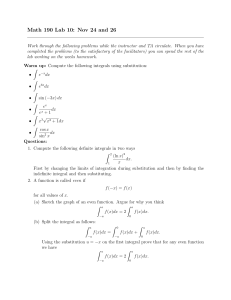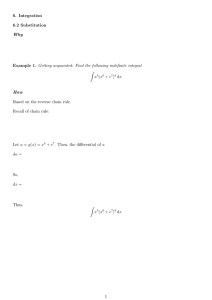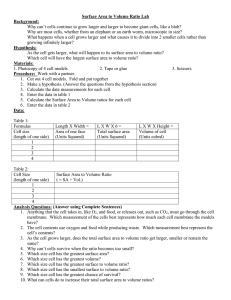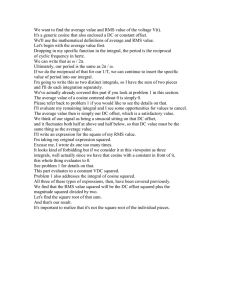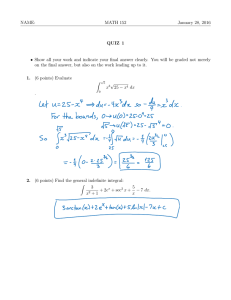MITOCW | MIT18_01SCF10Rec_65_300k
advertisement
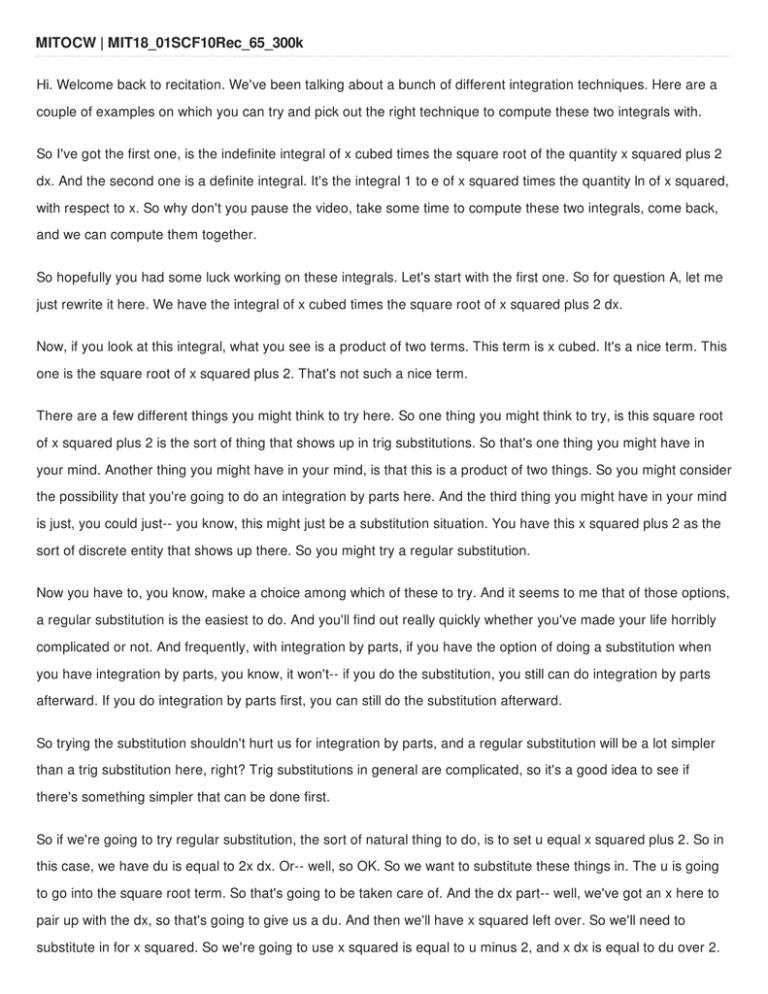
MITOCW | MIT18_01SCF10Rec_65_300k Hi. Welcome back to recitation. We've been talking about a bunch of different integration techniques. Here are a couple of examples on which you can try and pick out the right technique to compute these two integrals with. So I've got the first one, is the indefinite integral of x cubed times the square root of the quantity x squared plus 2 dx. And the second one is a definite integral. It's the integral 1 to e of x squared times the quantity ln of x squared, with respect to x. So why don't you pause the video, take some time to compute these two integrals, come back, and we can compute them together. So hopefully you had some luck working on these integrals. Let's start with the first one. So for question A, let me just rewrite it here. We have the integral of x cubed times the square root of x squared plus 2 dx. Now, if you look at this integral, what you see is a product of two terms. This term is x cubed. It's a nice term. This one is the square root of x squared plus 2. That's not such a nice term. There are a few different things you might think to try here. So one thing you might think to try, is this square root of x squared plus 2 is the sort of thing that shows up in trig substitutions. So that's one thing you might have in your mind. Another thing you might have in your mind, is that this is a product of two things. So you might consider the possibility that you're going to do an integration by parts here. And the third thing you might have in your mind is just, you could just-- you know, this might just be a substitution situation. You have this x squared plus 2 as the sort of discrete entity that shows up there. So you might try a regular substitution. Now you have to, you know, make a choice among which of these to try. And it seems to me that of those options, a regular substitution is the easiest to do. And you'll find out really quickly whether you've made your life horribly complicated or not. And frequently, with integration by parts, if you have the option of doing a substitution when you have integration by parts, you know, it won't-- if you do the substitution, you still can do integration by parts afterward. If you do integration by parts first, you can still do the substitution afterward. So trying the substitution shouldn't hurt us for integration by parts, and a regular substitution will be a lot simpler than a trig substitution here, right? Trig substitutions in general are complicated, so it's a good idea to see if there's something simpler that can be done first. So if we're going to try regular substitution, the sort of natural thing to do, is to set u equal x squared plus 2. So in this case, we have du is equal to 2x dx. Or-- well, so OK. So we want to substitute these things in. The u is going to go into the square root term. So that's going to be taken care of. And the dx part-- well, we've got an x here to pair up with the dx, so that's going to give us a du. And then we'll have x squared left over. So we'll need to substitute in for x squared. So we're going to use x squared is equal to u minus 2, and x dx is equal to du over 2. So when we make these substitutions in here, what we get is that this integral is equal to the integral of-- so it's x squared times the square root of x squared plus 2 times x dx. So that's u minus 2 times the square root of u times du over 2. Now, having made the substitution, we see-- OK. So with a little bit of rearrangement, this is just a sum of powers of u. Right? We can rewrite this as the integral of u to the 3/2 over 2 minus u to the 1/2 du. And now, this is just straightforward to integrate. So it turns out we don't need integration by parts. We don't need a trig substitution. Just this regular substitution works nicely. So we get, well, u to the 3/2, so we compute an antiderivative, so that gives us u to the 5/2. And I have to divide by 5/2, so I have to multiply by 2/5. And then I have a half. So it's u to the 5/2 over 5, minus-- so u to the 1/2, so that gives me 3/2, so I need minus 2/3 u to the 3/2. OK. And now to finish this off, I have to do my final back substitution, and replace u with x. So this is going to be x squared plus 2 over 5 to the 5/2 minus 2/3 times x squared plus 2 to the 3/2. All right. Plus a constant. Thank you, peanut gallery. Plus a constant. Right. Indefinite integral, should have had it right the very first time I went through. Plus a constant, both times. OK. Good. So that's all there is for part A. Now let's look at part B. So OK. So part B is a little more complicatedlooking. Let me copy it over here again. So part B, we have the integral from 1 to e of x squared times the quantity ln x squared dx. So again, there are a couple of possibilities for what we could want to do here. One thing is you could try just a regular substitution. So maybe a regular substitution you might want to try is u equals ln of x, or x equals e to the u. And now if you try that, you can try it, and what you'll see, is you'll get something. So here we have a polynomial times a function of the logarithm, a power of the logarithm. If you try that substitution, what you'll end up with is a polynomial in u times an exponential in u. So OK. So it's not clear that we've won anything, if we make that substitution. The other thing we can try, is we can try integration by parts here. Again, we have a product form. And if you make that substitution, you get polynomial times exponential, and that's also a promising place for integration by parts, after the substitution. So OK. So I'm not going to make the substitution. I'm just going to go-- seeing this product, I'm going to go for integration by parts directly. So I need to decide what pieces are which for integration by parts. And the thing to remember is this that-- so I have here a polynomial times a function of the logarithm. And the thing to remember is that polynomials like to be differentiated. That's their preference. But logarithms really, really like to be differentiated. You'd much rather differentiate a logarithm than integrate it. You can integrate a polynomial-- I mean you can integrate either of them. You can integrate a polynomial. When you integrate a polynomial, you get something that's still a fairly nice polynomial. Integrating logarithms is harder, whereas differentiating logarithms makes them into just powers of x. So setting this up as an integration by parts, we're going to want to take this, the everything with the logarithm in it, and that's the piece we want to differentiate, to try and simplify it. So that's going to be our u part. So we're going to try u equals ln x squared, and that leaves v prime to be x squared. So to do integration by parts-- OK. We need to differentiate and we need to integrate. So if I differentiate ln x squared, I get u prime. The prime is equal to-OK. Well, this is a little chain rule. So it's 2 ln x times the derivative of ln x, which is 1 over x. And if I integrate v prime, I get v is equal to x cubed over 3. OK. So now I use the formula for integration by parts. So I have that this integral-- what I'm going to do is I'm going to call this, let me give it a name, I. Now I'm going to come down here and I'm going to say, I is equal to-well, by integration by parts, it's equal to u*v minus the integral of u prime v dx. So in our case, u*v is x cubed over 3 times ln x squared. But the thing to remember is, this was a definite integral to start out with. It's from 1 to e. So when you take this part out front, you have to take the difference of its two values. So we're going to evaluate this between x equals 1 and x equals e, minus the definite integral-- so we still have a definite integral from one to e of u prime v. So that's 2/3-- OK. So now we have an ln x over x times x cubed. So the x and the x cubed, that cancels one power of x out of the numerator. So we're left with 2/3 x squared ln x dx. So. One thing we see, this is just going to be-- this is just going to evaluate to a constant. We're going to plug in e, and we're going to plug in 1, and we're going to take the difference. So that's just some number. This part is still some integral. Are we done yet? Well, it's not obvious immediately how to integrate this. I mean, I don't already know off the top of my head what the antiderivative here is. On the other hand, it's definitely simpler than what we started with, right? Before we had x squared ln x squared. Here we just have x squared ln x. So we've simplified the integrand. And it's still in a form in which we can further integrate by parts, if you wanted to. Right? So now in this case the natural thing to do would be very similar to what we did before. We're going to take the u to be the ln x, to be the piece we differentiate, and we're going to take the v to be x squared. OK? So we can do that. So this is equal to-- let's see. I'm going to bring it, now, upstairs. So this is equal to-- all right. So we plug in e here. We get e cubed over 3 times 1, minus when we plug in 1, ln of 1 is 0. So that just gives me e cubed over 3 for the first part minus-- all right, and I'm going to pull the 2/3 out front. So it's minus 2/3 times-OK. So now I'm going to do an integration by parts on this one. So again, like I said, I'm going to take u is equal to ln x. I'm going to take v prime is equal to x squared. So that means u prime is equal to 1 over x and v is equal to x cubed over 3. And so again, I get uv, which is x cubed over 3 ln x, and again, because it was a definite integral, I have to evaluate this between x equals 1 and e, minus-- OK. So minus the integral of u prime v. So this is the integral from 1 to e. u prime v is 1 over x times x cubed over 3, so that's x squared over 3 dx. OK, so having written all that down, what you see is this is a constant minus 2/3. OK. This is just some constant. We'll plug in e, we'll plug in 1. That's easy. And now we have an integral, and we've reduced this finally. Here we have just an integral of a polynomial. So an integral of a polynomial, that's easy to compute, you can do it yourself. And I'm going to let you finish off the last couple of steps for yourself. In the end, the answer should work out to 5 e cubed over 27 minus 2 over 27. This is what you should find the final answer to be when you work it all out. So I'll end there.
